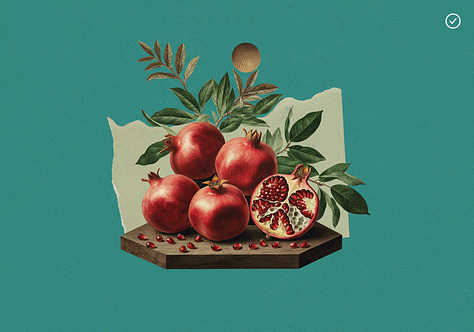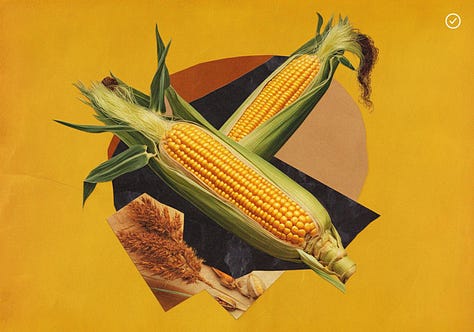The extremely online report: December 2024
A monthly digest of discourse, drama, and digital ephemera
Happy new year! While I’ve been blessedly AFK for most of December, the internet never sleeps. Let’s circle back on what happened in our corner of the web last month.
A tale of two AI-powered rebrands
December served up more spicy design discourse as two major studios tackled a similar challenge: generating hundreds of unique images at scale. Their different approaches—and receptions—tell us something about how to use AI in 2025.
Pentagram’s case study for government goal-tracking site Performance.gov sparked backlash when they revealed they used hand-made inputs and Midjourney to generate 1,500+ icons. Their Instagram comments are a mess with legendary illustrators like Julia Rothman, Christoph Niemann, and Mikey Burton commenting their concerns over AI’s impact on creative work and choice of tool—Midjourney faces legal scrutiny over using artists’ work without permission for training data.
Amid the firestorm, Paula Scher defended her team’s approach, noting it was “design with a capital D, not an illustration project” with no budget for outside illustrators. “This project didn’t take work away from anybody. There wasn’t a job there.”
Few critics tackled the quality of the work itself and its red, white, and bland output. (
unpacks their approach here, but I’m not a paying subscriber.) Reliably, writer (and former Pentagram employee) weighed in, tweeting with the following image: “Anyways, I think posting this in the case study is kind of telling on yourself.”Meanwhile, Smith & Diction’s work for nutrition app Alma, using the newly launched AI image generator Visual Electric (built on open-source models with transparent training data), earned positive praise. Testing approaches, the team discovered that a collage aesthetic could transform AI’s quirks (like misplaced elements or weird tomato stems) into intentional features and made AI generation core to the brand and product experience, with users getting custom food collages when they log meals.






While S&D built their creative concept around AI’s capabilities from the start, leaning into its strengths (and shortcomings) as a creative tool. The result is something suited to AI’s strengths rather than a cost-cutting replica of traditional illustration. Audience may play a role here, too—S&D caters a bit more to tech builders, while Pentagram is more popular with an older, more traditional graphic design crowd. As Designer Christopher Reath noted of another AI-supported rebrand: “new school’s taking old school’s lunch soon.”
The Luigi effect
The fatal shooting of UnitedHealthcare CEO Brian Thompson became an unexpected cultural phenomenon, exposing frustrations with American healthcare. The suspect, Luigi Mangione, transformed overnight into a TikTok sensation—complete with fashion inspiration, folk songs, and crypto tokens. The internet’s response was swift and dark, spawning endless memes and feral internet users running digital forensics on his accounts, from GoodReads to GitHub. True crime in the extremely online era.
The revenge of the humanities
Speaking of unexpected viral moments, Dr. Ally Louks’s simple “PhDone” post about her Cambridge thesis on “Olfactory Ethics” generated 117.1 million views and a case study in platform dynamics. The backlash—mostly men calling it “woke” and “useless”—showed how academic work can be a proxy for broader cultural anxieties about education, expertise, and institutional power. It also highlights a trend toward anti-intellectualism and weaponization of social media against academic discourse.
The year-end content industrial complex
While in/out lists still reign supreme, a new format emerged: “Things I changed my mind about.” From Semafor’s media figures to tech Twitter’s finest, everyone’s getting vulnerable about their L’s. Meanwhile, tech giants like Google Gemini and OpenAI are (almost) sliding into our DMs asking what we want them to build in 2025.
Nat Friedman: Renaissance man of the month
The former GitHub CEO casually dropped PlasticList, testing 312 Bay Area food products for plastic contamination. The findings? Your Boba Guys tea might contain more BPA than considered safe for an entire year. As Om put it: This is “gentleman journalism” at its finest.
Worth your time:
AI in the classroom: one teacher asks students if they want to be “predictable and average,” while another uses AI to create quizzes about students’ own papers
Mainframe launches with some extremely slick storytelling
A16z and YC dropped their 2025 wishlists
Something fun
Someone build a chatbot that can be an honest critic of your work
Shopify Editions Winter ’25 changelog (click the boring/not boring toggle)
PORTO ROCHA celebrates five years. HBD, buds!
If you’re in NYC, I rounded up art exhibitions to see this month
In other news: H-1Bs tearing the right apart, child left behind, UFOs over New Jersey, “what a year we had in highlighting the power of good marketing”, “you can just do things” thought piece when.
What’d I miss? Let me know in the comments. Stay weird, stay online.
—Carly





